[Editor’s Note: This article was written by guest contributor Alice Morrison, author of the book Dodging Elephants who lives in Morocco.]
Mohamad Ahansal is a man of considerable charm. He could, in fact, persuade almost anyone into anything. The first time I met him earlier this year in a café in Marrakech, Morocco he said, “Alice, come and do some translation for me at the Trans Atlas Marathon.” The Trans Atlas Marathon is the ultramarathon stage race Mohamad created and directs across the High Atlas mountains of Morocco. “I don’t speak good English and I have lots of competitors coming who need English,” he added. You don’t really say no to the five-time winner of the Marathon des Sables (MdS), and the thought of a jaunt in the Atlas was really appealing. I duly turned up, ready to do a bit of translation and was promptly, and, with a very mischievous chuckle, handed a race bib for the Trans Atlas Challenge, the shorter-distance event taking place alongside the Trans Atlas Marathon. The next six days were a blur of high peaks, the scent of wild thyme, brilliant blue skies, tiny Berber villages clinging to the rock, and evenings full of runners’ camaraderie and Berber drumming.
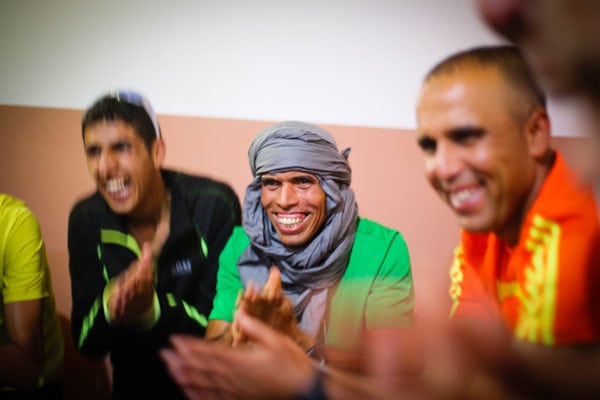
Mohamad Ahansal. Photo: Kirsten Kortebein
That week also gave me the chance to find out more about the man behind the myth. Mohamad Ahansal is one of the legendary Ahansal brothers, who between the two of them have won 15 of the 31 editions of the Marathon des Sables and who are national heroes.
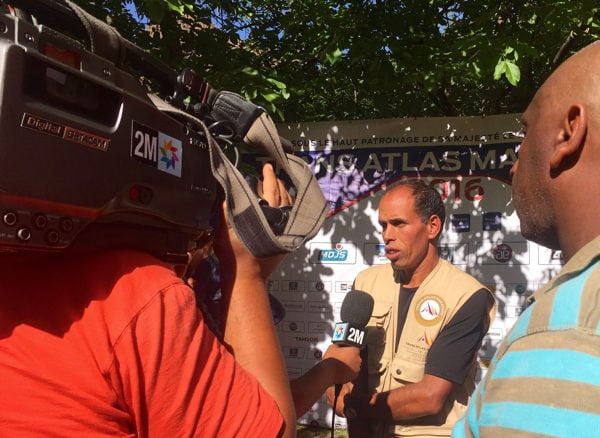
Mohamad Ahansal being interviewed while directing the 2016 Trans Atlas Marathon. Photo: iRunFar/Meghan Hicks
He started this year well, with a win at the Silk Road Ultramarathon in Iran, but his main focus for the summer was taking on the infamous STYR Labs Badwater 135 in California. He had been sponsored to run it for I Run 4 Ultra (part of Hope So Bright) to raise awareness of autism. Their aim is to publicize the issue and look at different ways to treat the symptoms and root causes of autism and alternatives to pharmaceutical interventions.
Mohamad is a Berber (Amazigh) hailing from near the desert town of Zagora in the Sahara Desert in Morocco. His earliest life was spent as a nomad, living under the shelter of a goat-hair tent with his family who subsided off the land and their herd of goats and sheep. Mohamad says that there is no life so hard, so tough as that of the desert nomad.
“You can’t imagine,” he says. “From 4:30 in the morning, you are up, working, struggling just for the basics to keep alive. You eat dates from the date palms and drink water from the small canals in the valley. Yes, sometimes you get meat but only when an animal is old. The young ones are taken to the market.”
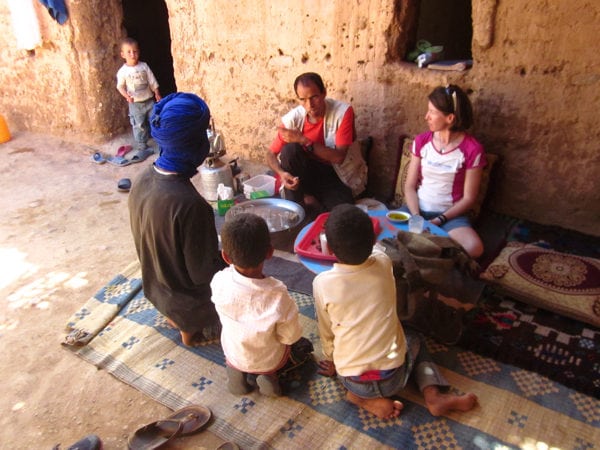
Mohamad Ahansal in 2013 with extended family and iRunFar Senior Editor Meghan Hicks at the homestead in which he was born. Photo courtesy of iRunFar/Meghan Hicks.
The awareness of that struggle still drives him.
When he was two, his father died. His uncle asked his mother to stay on with them with her five children but she wanted something different. She wanted an education for her children and so the family went to a village near the bustling town of Zagora where Mohamad’s grandfather had a house and there were schools.
“That decision changed my life and the life of my family,” says Mohamad. “My uncle is still in the same place, doing the same thing. I always tell children: school, school, school–first the pen and then the running shoes.”
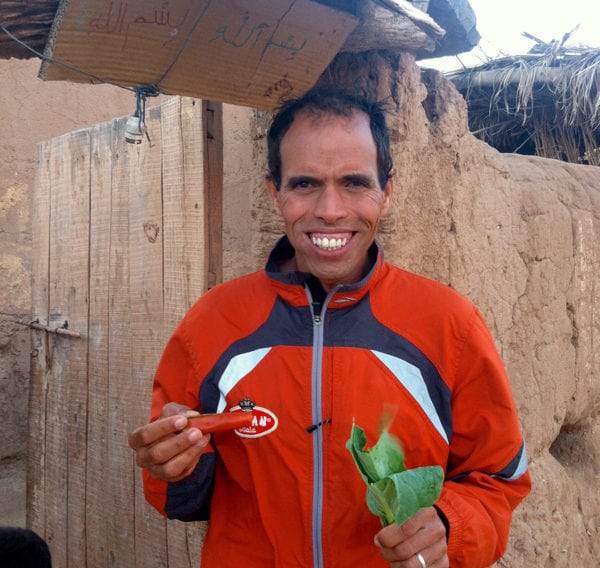
Mohamad Ahansal in 2013 at the entrance of the homestead at which he was born. Photo: iRunFar/Meghan Hicks
His start in competitive running came when he was 17. It was Eid Al Arsh (the festival of the coronation) on the third of March. Part of the celebrations included races for the young men of the area. Mohamad signed up alongside all his friends. He didn’t have proper running shoes so he wore his football boots. They were green, with heavy plastic soles. When he saw that everyone else had trainers on, he took them off, left them at the start, and ran barefoot. He came second and that was the first time he realized his abilities.
Mohamad had his brother, Lahcen, as an example and a training partner. The two men were to go on to be the greatest champions ever of the Marathon des Sables. The story the Ahansal brothers like to tell is that they were near Zagora when the runners from that year’s edition of MdS passed by.
“Why are all these men running through the desert,” they asked, “and why are they running so slowly?!”
In 1991, Lahcen ran MdS without an official race entry and was first but pulled back just before the finish line to allow the first official winner to run through. Then, the brothers sought out sponsors to pay their way into the race, and the legend began.
In 1998, Mohamad won his first MdS with a record-breaking time of 16 hours, 22 minutes, and 29 seconds. He was to win it a further four times in 2008, 2009, 2010, and 2013. He has also been runner-up 10 times and he has run the race a total of 19 times.

Mohamad Ahansal cartwheeling his way over the finish line in winning the 2013 Marathon des Sables. Photo: Cimbaly/V.Campagnie (c) MDS2013
But he wears his victories very lightly.
“I always try to do better, to improve–but victory is not the most important thing. Living a good life, trying to help others, to help your family and those who don’t have as much as you, to do that throughout your life is the important thing. Doing something for others is what leaves a legacy, not winning something and talking about it in the press.”
Two brothers, one race. What does that feel like, competing with someone so close to you, sometimes winning but more often coming in second. I was interested to know whether sibling rivalry was a factor or not.
“In the family, we are brothers,” says Mohamad,” but in the race we were not. We did cooperate. It makes it easier if you can work with someone to get you through, but sometimes we raced totally on our own, with our own race plan, our own tactics.
“But there is something. If Lahcen was in front, I was okay, I automatically relaxed, but if someone else was, I would chase them down. I always wanted a first and second place for the family. There WAS competition, but within limits. After all, it is a race, not a war. And Lahcen was maybe stronger than me mentally. As I said, I automatically relaxed when he was in front, that is the difference.”
It was after that first MdS win in 1998 that fate took a hand. Mohamad was working as a desert guide and met a German businessman, Lutz Ulla, and his family. They didn’t have any language in common but communicated through signs and drawing in the sand. It must have worked, because Lutz went on to be a mentor and sponsor and to change the course of his life.
He invited Mohamad to come and run his first road marathon and his first marathon abroad in Frankfurt, Germany. Just getting the visa was a nightmare. The Moroccan Athletics Federation refused to recognize Mohamad as an athlete, saying the MdS didn’t count as a proper race and things ground to a halt. Despondent, Mohamad went to the embassy to get his passport back and when he opened it, he found the visa inside. Lutz had talked to the organizers of the Frankfurt Marathon, who contacted the embassy and he got the visa.
So, what was it like standing on a cold, windy start line in Germany?
“I was thinking about the run. I wanted to do a good run to make my friends proud. I was preparing myself to do well and for that to help my future in the sport. But when I saw the other athletes, and their equipment, I thought, Hmmm. For the first half, I stayed with the front group and attacked with the Kenyans. But then I realized I couldn’t do it. I came in 17th or 18th in the end with a time of 2:23.”
With Lutz’s help, Ahansal went back to Germany to undertake three months of training to try and get his time down to sub-2:15 in preparation for the Hamburg Marathon. From a minimal training regime in the desert, which consisted of mainly running, Mohamad was suddenly in a full program.
“I changed everything,” he says. “I did lots of speedwork–running on the track. I had a good plan. One month before Hamburg, I did a time of 1:05 in the Berlin Half [Marathon]. Then I had a period of really intense training planned to get me in peak form. Two weeks before Hamburg, I got injured. My muscles weren’t used to running on the track in spikes and that was it.”
It was to be a turning point for the young man.
“I realized two things. The first is that sport is risky and unpredictable. I had done three months of intense training and then one injury meant it was over. The second was that you can’t make a living from this sport. (Or at least I couldn’t.) The prize money could not cover your living costs. In Morocco I could see sports men who had been at the very top and then… nothing. I decided to concentrate 70% on work and 30% on sport. To start building for the future.”

Mohamad Ahansal winning the long stage of the 2010 Marathon des Sables. Photo: AFP/Getty Images/Pierre Verdy
So, what brought him to Badwater?
“I had met Linda Sanders, and she asked me to run for I Run 4 Ultra and Hope So Bright in the Grand to Grand Ultra [in 2015]. When I went, I came second. I felt that I should come back to take the title because I had got lost en route and I felt sure I could take it next time. But Linda persuaded me to do Badwater instead to help raise awareness of autism. I agreed because I like to run for a reason, for a cause–it gives meaning to the run and the harder the effort, the more I feel that you are giving to the cause.”
And what about training and preparation for the event?
“Tadrib bidoon Tadrib,” says Mohamad in Arabic and laughs. It means “training without training.” He went on to tell me that he believes in all-over conditioning but keeping it within limits and not overtraining to injury, harking back to Hamburg. His main regimen for Badwater consisted of altitude training around Mount Toubkal in the High Atlas, which tops out at 4167 meters altitude, and of course, lots of heat training in his home in Zagora. But would that training be the right strategy for this notoriously difficult race, which is run on a paved road?
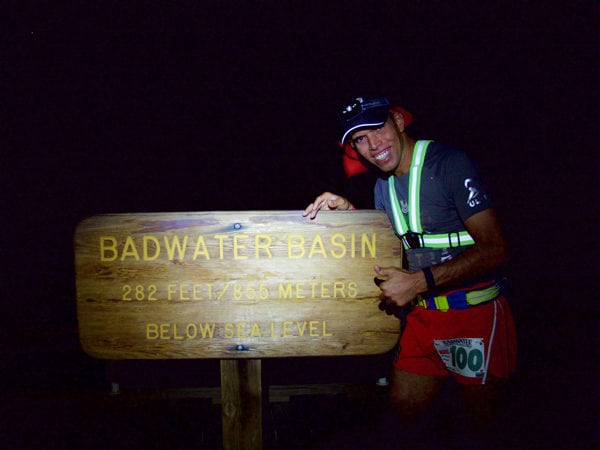
Mohamad Ahansal before the start of the 2016 Badwater. Photo: Alessandro Beltrame
Badwater is a very particular race. It is 135 miles on the road in one stage, starting from Death Valley, California in the broiling heat, and combining that with some serious climbing over three mountain ranges amounting to 4450 meters of vertical ascent. It is acknowledged as one of the more difficult races in the world.
Many of the elements of the race were familiar to Mohamad, particularly the heat and the mountains, but this would be the longest distance he had ever run in one go and it is run on tarmac, something he is not used to.
His entrance into America for the start of the race was not an auspicious one. As he had been in Iran earlier in the year, he had an Iranian stamp in his passport, which was something that the immigration officers took exception to. He spent eight hours being held and questioned in immigration until everything was checked out. Then, to compound his woes, his baggage containing all his kit was lost.
He had packed his race shoes in his bag, and so he was forced to buy new ones. Most racers have planned their race-day kit well in advance and everything is tried and tested. Forced into the unenviable position of getting new shoes on the eve of a huge race, Mohamad decided to go for Hokas, but this was to be the first time he had ever run in the brand, let alone this particular pair of shoes, and he had a long, paved road ahead.
If you see pictures of Mohamad at the start line of the race, he looks worried.
“Yes, the atmosphere at the start was subdued. Everyone was thinking about the distance, about the difficulty that lay ahead. When I saw the pre-race photo I realized that no one was smiling. During the race, things picked up and it was great to have all the encouragement along the route from the support teams, but the start was…”
The elite wave of runners for Badwater, including Mohamad, set off at 11:30 p.m. Pacific Standard Time on Monday, July 18. At the first checkpoint at 17 miles, he was lying in 12th place and was running strongly. However, trouble started to kick in over the next 20 miles and his position dropped to 25th with a time of 7 hours, 17 minutes at 41 miles. His aim going in had been to make the top 10, and this was way off the mark.

The elite wave of the 2016 Badwater. Photo: Alessandro Beltrame
“From the beginning, I felt a bit off. I had things on my mind: the troubles with immigration, when they kept me back for eight hours because I had an Iranian stamp in my passport, and the new shoes which I had only just bought. I didn’t have a problem with the heat or the ascent. But I overcame that negativity and kept going.”
There were two very serious problems for Mohamad and they were the fact that he is not used to training or racing on paved roads, and wearing a brand-new style of shoe over such a long distance and in such difficult conditions.

Mohamad Ahansal during the 2016 Badwater. Photo: Alessandro Beltrame
It was to prove too much.
“It wasn’t easy for me. I prefer the trail to the road and I wasn’t mentally comfortable but I could have overcome that. The problem was my knees, an old problem. First my right and then my left started to go and just after a long descent of about eight miles it became impossible and I had to take the decision to stop. I can overcome discomfort and suffering but when it becomes an issue of causing long-term damage and serious injury, when it is a matter of your health, then you have to stop.”
Any DNF is a grave disappointment, but when I talked to him straight afterward, Mohamad was already thinking forward.
“I would train completely differently. I would have to totally revise what I do normally and do at least 50% on the road. If I come again I would want to prepare with a number of road marathons and longer distances including at least a 100-kilometer run. I’d also get here a week early so that if there were any problems at the airport, or with my luggage, I could overcome them.”
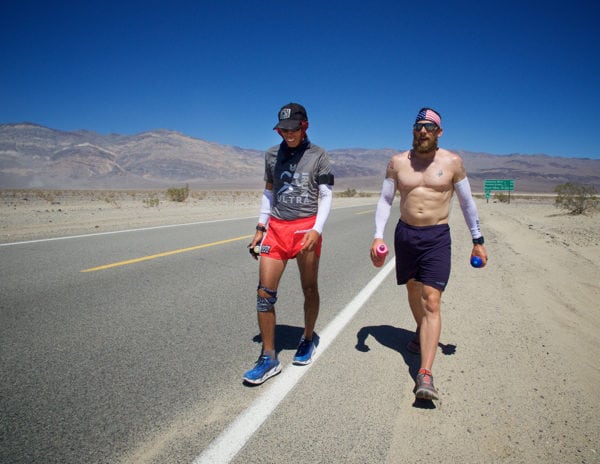
Mohamad Ahansal walking because of knee problems during the 2016 Badwater. Photo: Alessandro Beltrame
Every runner comes to a race determined to finish, and the fact that he had come to race for I Run 4 Ultra to raise awareness of children with learning difficulties meant a lot to him.
“You know, Linda (Founder of I Run 4 Ultra) had organized everything so perfectly. The support team was amazing and did everything they could for me. As I was running and my knees were getting worse and worse, I kept thinking about the cause I was running for. I did my best for them, every kilometer was for those children, I did my maximum.”
As my final question, I wanted to ask Mohamad what his spirit animal was. After the 2016 MdS I interviewed American runner Harvey Lewis, who participated in the race, and he said he chooses a spirit animal for every race. He chose the dung beetle for MdS, but that is another story. Getting the concept over to Mohamad was a bit tricky and we had to resort to three different languages to get there but in the end, we did.
“Everything that is difficult has a value. I like to overcome difficulties, like an ant, always moving this way and that to get over an obstacle. I am like an ant, a desert ant.”
Call for Comments (from Meghan)
Do you know Mohamad Ahansal? Can you tell stories about your experiences with him?

Mohamad Ahansal during Stage 5 of the 2014 MdS. Photo: Kirsten Kortebein
